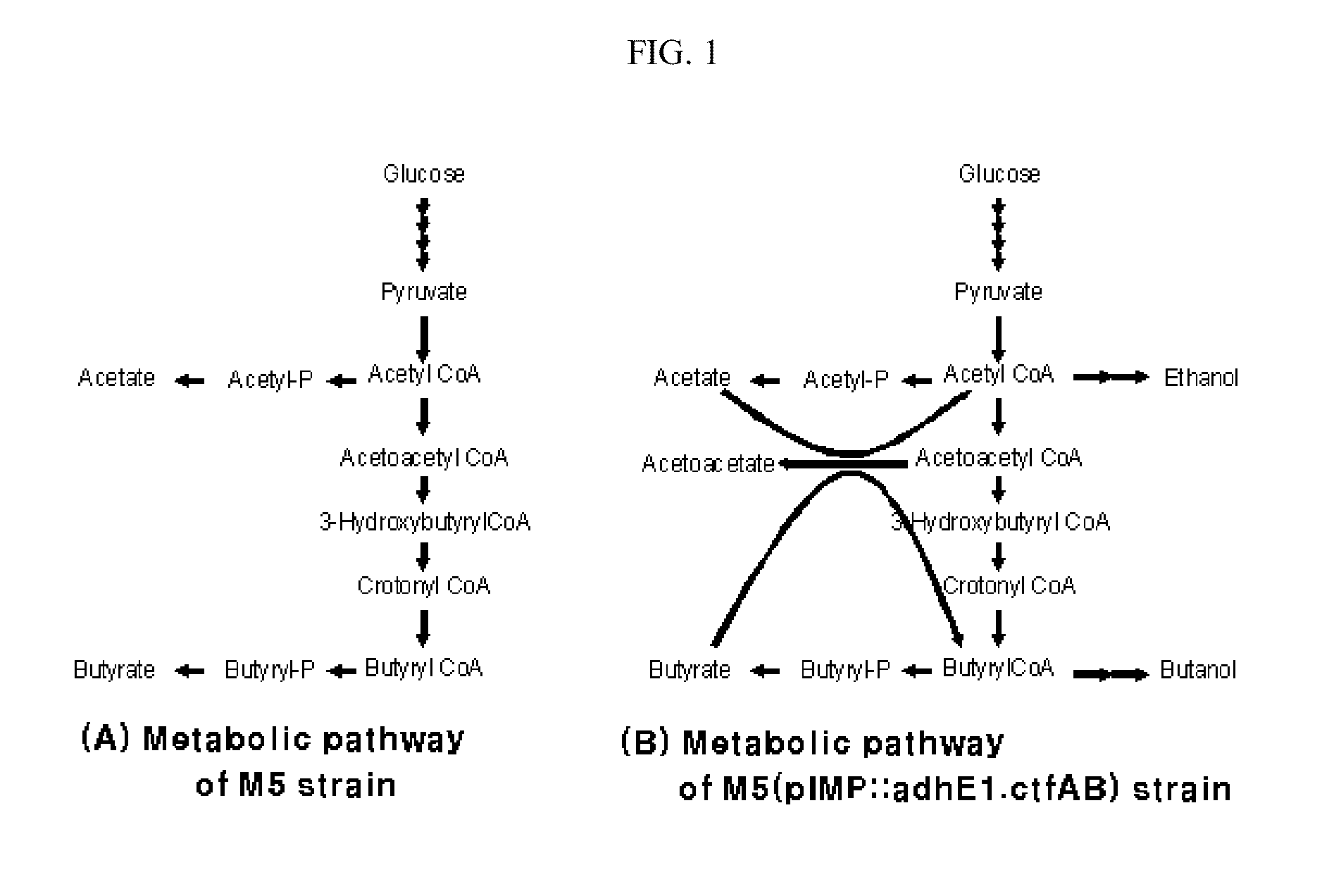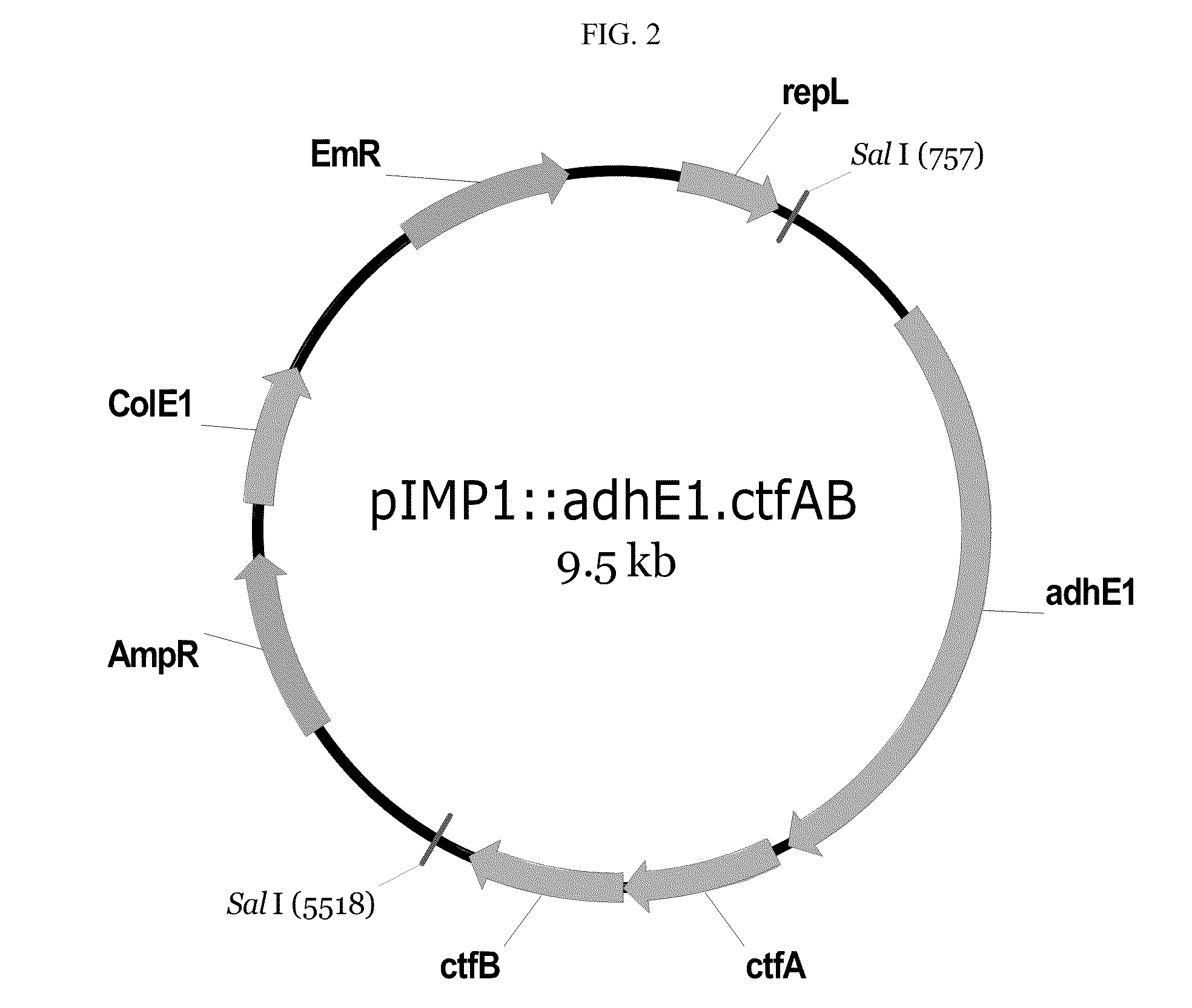Enhanced ethanol and butanol producing microorganisms and method for preparing ethanol and butanol using the same
a technology of ethanol and butanol, which is applied in the field of recombinant microorganisms, can solve the problems of large scale facilities, inefficient cost and energy, and limited use of fossil fuel as a basic material, and achieves high efficiency
- Summary
- Abstract
- Description
- Claims
- Application Information
AI Technical Summary
Benefits of technology
Problems solved by technology
Method used
Image
Examples
example 1
Preparation of a Recombinant Vector Containing adhE1 Gene Encoding Alcohol / Aldehyde Dehydrogenase, and ctfAB Gene Encoding CoA Transferase
The adhE1, ctfA and ctfB genes of Clostridium acetobutylicum ATCC 824, which have the base sequences of SEQ ID NO: 3, SEQ ID NO: 4 and SEQ ID NO: 5, respectively, were cloned together with the promoter and transcription termination sequences thereof. First, using chromosomal DNA of Clostridium acetobutylicum ATCC 824 as a template, PCR (Table 1) was performed with the primers of SEQ ID NO: 1 and SEQ ID NO: 2, then the obtained adhE1, ctfA and ctfB genes were cut with the restriction enzyme SalI and inserted into Clostridium / E. coli shuttle vector pIMP1 (Mermelstein, L. D. et al., Bio / Technol., 10:190, 1992) cut with the same restriction enzyme, thus preparing a recombinant vector pIMP1::adhE1 ctfAB (FIG. 2). Genes (adhE1, ctfAB) derived from Clostridium acetobutylicum ATCC 824, which encode alcohol / aldehyde dehydrogenase and CoA transferase, were ...
example 2
Construction of Recombinant Microorganisms
M5(pIMP1::adhE1.ctfAB) strain was constructed by introducing the recombinant vector pIMP1::adhE1 ctfAB constructed in Example 1 into Clostridium acetobutylicum M5 strain by electroporation. First, the recombinant vector of Example 1 was introduced into Escherichia coli TOP10, which contains the vector pAN1 expressing Bacillus subtilis Phage Φ3T I methyltransferase (Mermelstein et al., Appl. Environ. Microbiol., 59:1077, 1993) to induce methylation thereof, such that the vector becomes suitable for transformation into Clostridium. The methylated vector was isolated and purified from E. coli, and then introduced into a mutant strain of Clostridium acetobutylicum M5 (Cornillot et al., J. Bacteriol., 179:5442, 1997) which lacks megaplasmid (carrying 176 genes, including a gene encoding acetoacetic acid decarboxylase, a gene encoding CoA transferase and a gene encoding alcohol / aldehyde dehydrogenase), thus preparing a recombinant microorganism. I...
example 3
Production of Ethanol / Butanol Using the Recombinant Microorganism M5(pIMP1::adhE1.ctfAB)
The recombinant microorganism M5(pIMP1::adhE1 ctfAB) prepared in Example 2 was cultured to examine the performance. A 30 ml test tube containing 10 ml of CGM medium was sterilized, taken out at a temperature higher than 80° C., charged with nitrogen gas, and cooled to room temperature in an anaerobic chamber. Then, 40 μg / ml of erythromycin was added to the medium, and the recombinant microorganism was inoculated, then preculture was carried out at 37° C. in an anaerobic condition to an absorbance of 1.0 at 600 nm. A 250 ml flask containing 100 ml of the medium with said composition was sterilized, the medium was inoculated with 6 ml of the preculture broth, and the second preculture was carried out at 37° C. in an anaerobic condition to an absorbance of 1.0 at 600 nm. Then, a 5.0 L fermentor (LiFlus GX, Biotron Inc., Kyunggi-Do, Korea) containing 2.0 L of the medium with said composition was ster...
PUM
| Property | Measurement | Unit |
|---|---|---|
| pH | aaaaa | aaaaa |
| concentration | aaaaa | aaaaa |
| OD | aaaaa | aaaaa |
Abstract
Description
Claims
Application Information
 Login to View More
Login to View More - R&D
- Intellectual Property
- Life Sciences
- Materials
- Tech Scout
- Unparalleled Data Quality
- Higher Quality Content
- 60% Fewer Hallucinations
Browse by: Latest US Patents, China's latest patents, Technical Efficacy Thesaurus, Application Domain, Technology Topic, Popular Technical Reports.
© 2025 PatSnap. All rights reserved.Legal|Privacy policy|Modern Slavery Act Transparency Statement|Sitemap|About US| Contact US: help@patsnap.com


